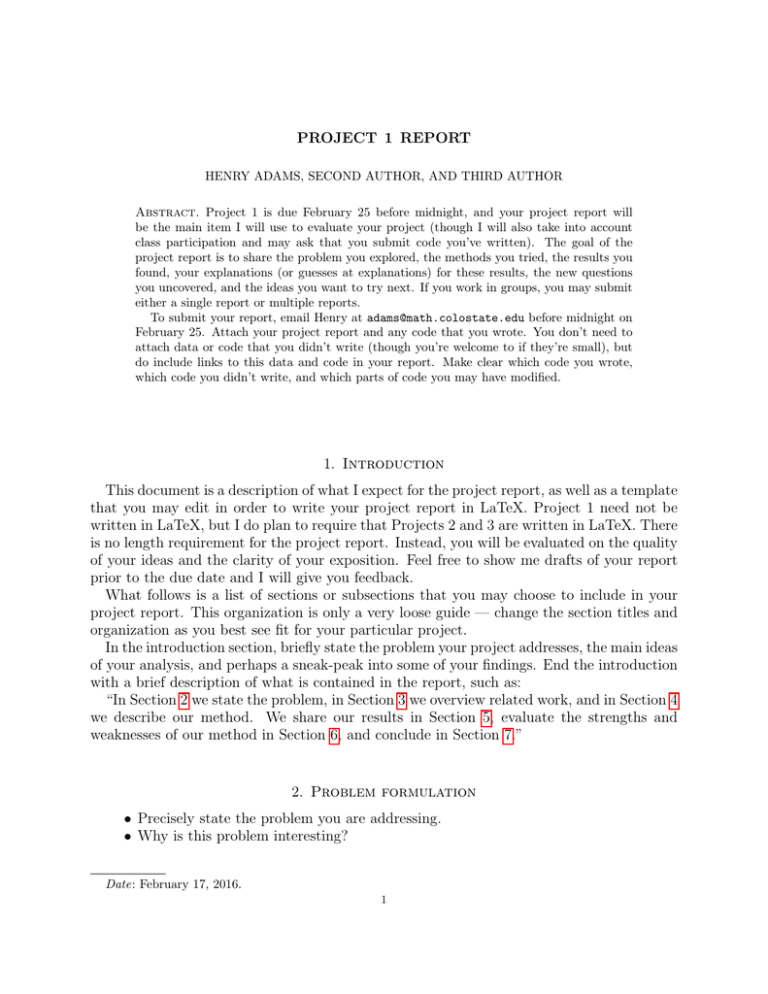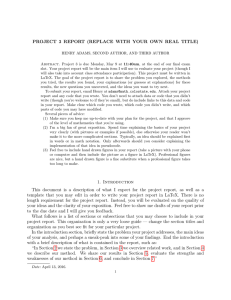PROJECT 1 REPORT
advertisement

PROJECT 1 REPORT HENRY ADAMS, SECOND AUTHOR, AND THIRD AUTHOR Abstract. Project 1 is due February 25 before midnight, and your project report will be the main item I will use to evaluate your project (though I will also take into account class participation and may ask that you submit code you’ve written). The goal of the project report is to share the problem you explored, the methods you tried, the results you found, your explanations (or guesses at explanations) for these results, the new questions you uncovered, and the ideas you want to try next. If you work in groups, you may submit either a single report or multiple reports. To submit your report, email Henry at adams@math.colostate.edu before midnight on February 25. Attach your project report and any code that you wrote. You don’t need to attach data or code that you didn’t write (though you’re welcome to if they’re small), but do include links to this data and code in your report. Make clear which code you wrote, which code you didn’t write, and which parts of code you may have modified. 1. Introduction This document is a description of what I expect for the project report, as well as a template that you may edit in order to write your project report in LaTeX. Project 1 need not be written in LaTeX, but I do plan to require that Projects 2 and 3 are written in LaTeX. There is no length requirement for the project report. Instead, you will be evaluated on the quality of your ideas and the clarity of your exposition. Feel free to show me drafts of your report prior to the due date and I will give you feedback. What follows is a list of sections or subsections that you may choose to include in your project report. This organization is only a very loose guide — change the section titles and organization as you best see fit for your particular project. In the introduction section, briefly state the problem your project addresses, the main ideas of your analysis, and perhaps a sneak-peak into some of your findings. End the introduction with a brief description of what is contained in the report, such as: “In Section 2 we state the problem, in Section 3 we overview related work, and in Section 4 we describe our method. We share our results in Section 5, evaluate the strengths and weaknesses of our method in Section 6, and conclude in Section 7.” 2. Problem formulation • Precisely state the problem you are addressing. • Why is this problem interesting? Date: February 17, 2016. 1 3. Related work Have other people [1] worked on similar things? Feel free to try something on your own first and then only later look into what others have done later — in this class it’s fine if you reinvent the wheel. 4. Our method What approach are you taking to address this problem? What assumptions are you making? What are some of the justifications for your method? 5. Results What results did you find? What are your explanations (or best guesses at explanations) for these findings? If your method depends on the choice of parameters, how sensitive are your results to those parameters? The rest of this section contains example math equations, figures, and tables in LaTeX. 5.1. Example math equations. Here are example math equations: ax2 + bx + c = 21 eπi or R 1 e−kuk1 du = 22i+1 Ci . You can also write math equations on their own line, such as Ki Z 5 Z 5 sin(x)dx ≤ | sin(x)|dx < ∞ −3 −3 or ∞ ∞ X 1 X x i 1 1 i √ Ci x = . Ci = 2i+1 2 2 i=0 4 1+ 1−x i=0 5.2. Example figure. Here is anZigzag example persistence figure (see Figure 1): !→ !→ !→ ←! ←! ←! ←! !→ •! Given X → I , form ZX and take Hd−1 (ZX) . Figure 1. Here is an example caption. 2 5.3. Example table. Here is an example table: title1 title2 title3 15 cell π 9 ax − y test √ 42 ∞ 2 6. Discussion and future work What are some of the pros and cons of your method? What extensions could be added? Do you have any predictions, guesses, or wild conjectures that you’d like to make? What are some avenues for future work, or questions that could be considered next? 7. Conclusion Summarize the main ideas and key points of your project. 8. Acknowledgements Acknowledge people (besides me or your project group) who helped you with various aspects of your project — for example other students in Math 435 or other faculty at CSU you may have gotten advice from. Acknowledge places where you borrowed code. References [1] Pearson, Karl. On lines and planes of closest fit to systems of points in space. The London, Edinburgh, and Dublin Philosophical Magazine and Journal of Science, 2.11 (1901): 559–572. 3



